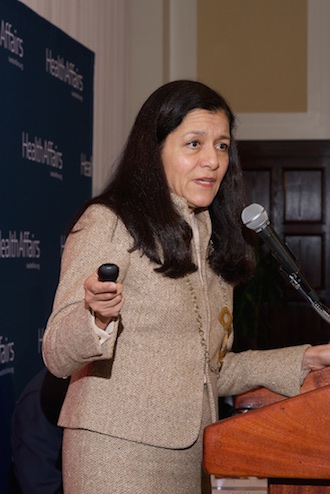Child Opportunity Index outlined at Health Affairs event
The Child Opportunity Index is a new measurement tool that rates the quality of opportunities for children on a neighborhood and regional level
 Photo/Bob Stevens, ©rlstevensphotography
Photo/Bob Stevens, ©rlstevensphotographyDolores Acevedo-Garcia speaks at the National Press Club in an event held by Health Affairs.
Dolores Acevedo-Garcia, the Samuel F. and Rose B. Gingold Professor of Human Development and Social Policy and director of the Institute for Child Youth and Family Policy, was among a group of featured authors from the November issue of Health Affairs to speak at the National Press Club in Washington, D.C. on Wednesday.
Acevedo-Garcia discussed her article, “The Child Neighborhood Opportunity Index: a tool for improving the collaboration between community development and public health," co-authored with researchers from the Heller School and the Kirwan Institute for the Study of Race and Ethnicity at The Ohio State University. The Child Opportunity Index is a new measurement tool that rates the quality of opportunities for children on a neighborhood and regional level, based on indicators such as availability of quality early childhood education, healthy physical environments, and supportive socioeconomic environments.
Analysis of the Index across the 100 largest U.S. metropolitan areas found that high concentrations of black and Hispanic children live in the lowest-opportunity neighborhoods within their metropolitan areas. Forty percent of black and 32 percent of Hispanic children live in very low-opportunity neighborhoods within their metropolitan area, compared to 9 percent of white children. This inequity persists across metropolitan areas but is greater in some areas, especially those with high levels of residential segregation.
The diversitydatakids.org website features a number of ways to explore and utilize the Child Opportunity Index. Interactive maps allow users to overlay Census population data on the Child Opportunity Index, showing where children of different racial and ethnic groups live and how these patterns correspond with levels of neighborhood opportunity. Users can also create interactive rankings and bar charts to gain further insights into the differing geographies of opportunity that children face in their neighborhoods.
“Policy makers increasingly recognize the concept of neighborhood opportunity in the development of housing for low-income families,” Acevedo-Garcia said. “Through its web-based mapping system and database, the Child Opportunity Index offers a valuable new tool to the housing and community development fields that is unique both in its focus on children and in its ability to facilitate analyses of racial and ethnic inequities.”
Categories: Humanities and Social Sciences, Research





